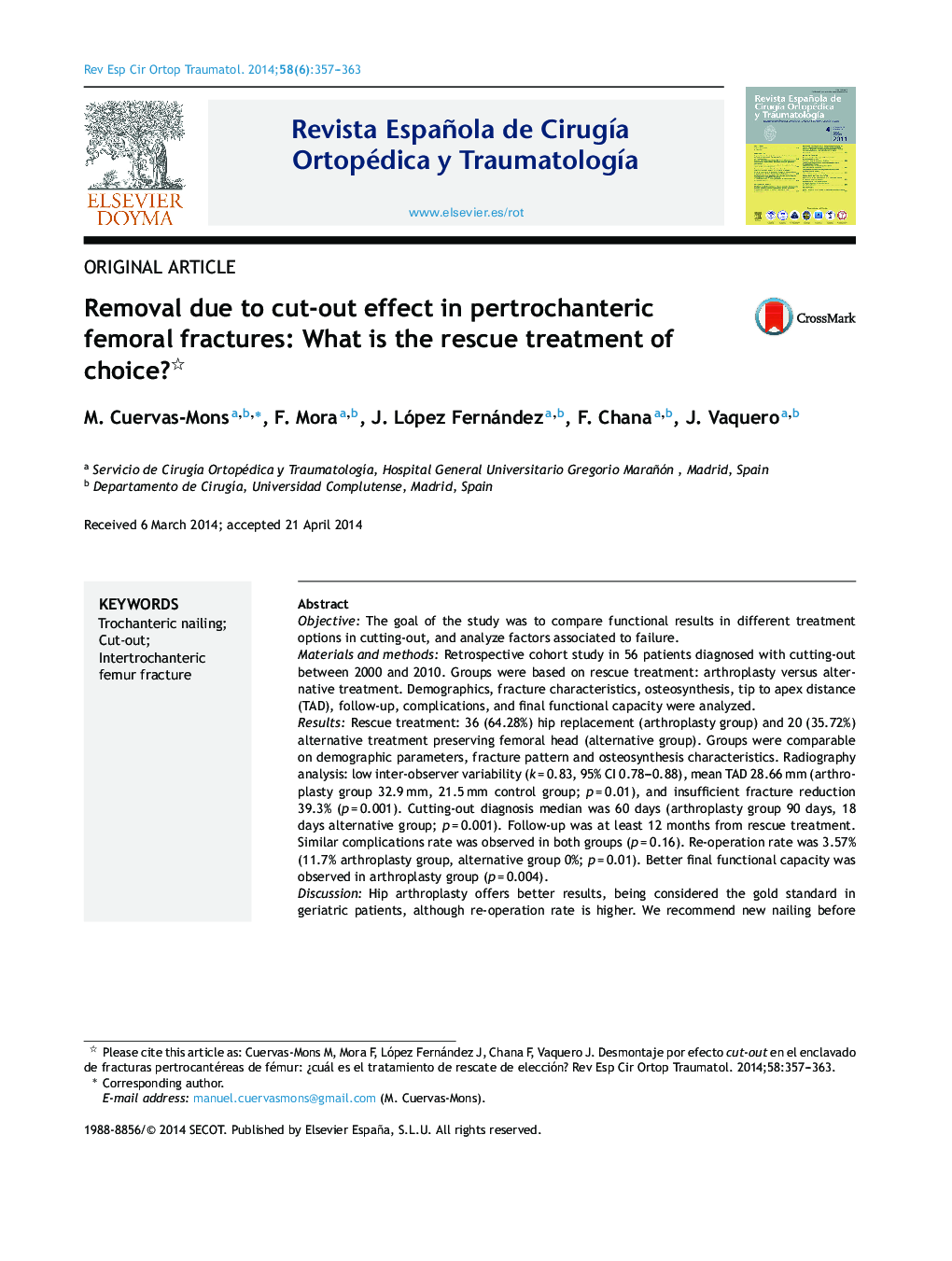| کد مقاله | کد نشریه | سال انتشار | مقاله انگلیسی | نسخه تمام متن |
|---|---|---|---|---|
| 4087185 | 1268021 | 2014 | 7 صفحه PDF | دانلود رایگان |

ObjectiveThe goal of the study was to compare functional results in different treatment options in cutting-out, and analyze factors associated to failure.Materials and methodsRetrospective cohort study in 56 patients diagnosed with cutting-out between 2000 and 2010. Groups were based on rescue treatment: arthroplasty versus alternative treatment. Demographics, fracture characteristics, osteosynthesis, tip to apex distance (TAD), follow-up, complications, and final functional capacity were analyzed.ResultsRescue treatment: 36 (64.28%) hip replacement (arthroplasty group) and 20 (35.72%) alternative treatment preserving femoral head (alternative group). Groups were comparable on demographic parameters, fracture pattern and osteosynthesis characteristics. Radiography analysis: low inter-observer variability (k = 0.83, 95% CI 0.78–0.88), mean TAD 28.66 mm (arthroplasty group 32.9 mm, 21.5 mm control group; p = 0.01), and insufficient fracture reduction 39.3% (p = 0.001). Cutting-out diagnosis median was 60 days (arthroplasty group 90 days, 18 days alternative group; p = 0.001). Follow-up was at least 12 months from rescue treatment. Similar complications rate was observed in both groups (p = 0.16). Re-operation rate was 3.57% (11.7% arthroplasty group, alternative group 0%; p = 0.01). Better final functional capacity was observed in arthroplasty group (p = 0.004).DiscussionHip arthroplasty offers better results, being considered the gold standard in geriatric patients, although re-operation rate is higher. We recommend new nailing before arthroplasty in early failure (4 weeks) in patients with femoral head integrity. An insufficient fracture reduction is the main short-term factor predicting failure; and TAD higher than 20 mm is a middlelong-term one.
ResumenObjetivoComparar los resultados funcionales de las distintas opciones terapéuticas, y analizar los factores técnicos asociados al cut-out.Material y métodoEstudio de cohortes retrospectivo de 56 pacientes diagnosticados de cut-out entre 2000-2010, divididos en dos grupos en función del tratamiento de rescate: artroplastia frente a conservar la cabeza femoral (alternativo). Se analizaron datos demográficos, características de la fractura y osteosíntesis, tip to apex distance (TAD), seguimiento, complicaciones y capacidad funcional final.ResultadosGrupo artroplastia 36 pacientes (64,28%) y 20 (35,72%) grupo alternativo. Comparables en parámetros demográficos, comorbilidades, patrón de fractura y características de la osteosíntesis. Se observó poca variabilidad interobservador (k = 0,83; IC 95%: 0,78-0,88) en el análisis radiográfico; con un TAD medio de 28,66 mm (p = 0,01) y un déficit de reducción en el 39,3% (p = 0,001). La mediana de cut-out fue de 60 días (artroplastia 90, alternativo 18; p = 0,001). Seguimiento mínimo 12 meses, con tasa de complicaciones similar en ambos grupos (p = 0,16) y de reintervención del 3,57% (p = 0,01). La capacidad funcional final fue mayor en el grupo de artroplastia (p = 0,004).ConclusiónEl tratamiento de rescate con artroplastia ofrece mejores resultados funcionales, considerándolo el tratamiento de elección en pacientes ancianos, aunque la tasa de reintervención es mayor. Recomendamos nuevo enclavado antes que artroplastia en los casos de cut-out temprano (<4 semanas) en aquellos casos que se mantenga la integridad de la cabeza femoral. Un déficit de reducción de la fractura es el principal factor predictor de fallo a corto plazo; un TAD por encima de 20 mm lo es a medio-largo plazo.
Journal: Revista Española de Cirugía Ortopédica y Traumatología (English Edition) - Volume 58, Issue 6, November–December 2014, Pages 357–363